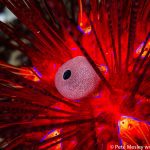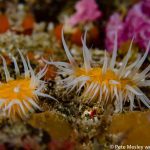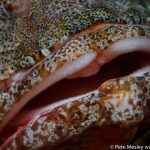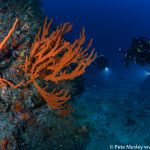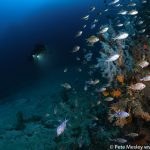Poor Knights Islands: History/Biology
The Gem of the Southern Hemisphere!
The Poor Knights Islands are an internationally recognized icon, up for World Heritage Status and 23km off the Tutukaka Coast where the island’s 11 million year old volcanic origins provide myriad spectacular drop offs, walls, caves, arches and tunnels, all inhabited by an amazing array of underwater life. Isolated from the mainland for many thousands of years, they are the remnants of ancient volcanoes that erupted in the Pacific Ring of Fire.
Converging warm water currents, a micro -climate and thousands of years of separation from the mainland have resulted in a unique biodiversity. Washed by the warmth sweeping down from the Coral Sea, the Poor Knights Islands are ever present on the horizon of most of the North East coast of Northland, and the easiest harbour by which to access them is Tutukaka. Although the trip will only take a little over 35 minutes, it is a world away as you venture out to this “Middle Earth in the Middle of the Ocean”.
Below the water, for 800 metres around the islands, is a marine reserve. Above, the islands are a nature reserve.
Declared tapu by local Maori almost 140 years ago after a bloody massacre, the history is dramatic. Over 400 people use to live on the islands, with pa sites, marae, and terraced gardens. Left to nature, the archaeological remnants are the most pristine in New Zealand’s heritage, the only disturbance being the roots of the mighty pohutukawa canopy that has risen overhead.
Directly on the migratory path of a number of species, any trip is often accompanied by both Common and Bottlenose dolphins and there are several species of whales, including orca, minke, Bryde’s and pilot whales that feed off the coast. A Marine Mammal Permit is required to divert your vessel’s course to interact with these creatures, but if you are lucky enough, they will come to you!
The Department of Conservation diligently protects the Poor Knights Islands and rightly so; they are home to a wide variety of rare and endangered native insects, reptiles and molluscs.
After the initial Maori settlement was abandoned in the 1820′s, and the island was rid of the remaining pigs in 1936, the native bush began to flourish as it once did. There are still stands of ancient forest, and the secondary bush has regenerated strongly from them. One of New Zealand’s largest pohutukawa forests exists on the islands, and predominate the seaward slopes, exploding in a vibrant sprinkling of red over the top of the island every year during November and December. Known as the NZ Christmas tree, their bright red flowers blanket the island and supposedly reminded Captain Cook of his jam covered “Poor Knights pudding”, hence one story behind the naming of the islands.
Other coastal natives found on the island include kohekohe, Tawapou, ngaio, taupata, karo, mahoe and karamu. Astelias, flax and toetoe and ringaringa cling to rocky outcrops and inland cliffs, and some species are distinctive from the mainland varieties. Suffering from what is called gigantism, they are larger leaved and stemmed than their cousins.
Endemic species include the Poor Knights maupo, and the Poor Knights houhere, but the best known would have to be the Poor Knights Lily, Xeronema callistemon. This beautiful lily takes 7-8 years before it produces a bottle-brush-like stem that erupts into red flowers. Clinging to cliffs, and hardy flax like plants, the lily can grow to enormous clump sizes. In October they produce their flowers that last for several months.
The complex underwater landscape is a unique environment. Subtropical and temperate marine life coexists with extraordinary diversity, beauty and density. Over 125 species of fish share this environment with soft corals, encrusting sponges, vibrant anemones, ecklonia kelp forests, mating sting rays, visiting pelagic manta rays, gorgonian fans and myriad other life forms. Having been a Marine Reserve for over 20 years the fish behaviour continues regardless and they interact quite happily with snorkellers, divers and swimmers.
Tropical visitors – some larval, some larger – arrive in the summer months, brought down on the East Auckland current. Originating from tropical waters off the Australian east coast, the current passes Lord Howe and Norfolk Islands before turning Southeast to run parallel to Northland’s East coast.
The Islands must seem like an oasis; many tropical visitors settle on the reef permanently. The Island are too cool for some visitors; the manta, humpbacks and turtles only pass through.
Diving at the Poor Knights is rewarding at all times of the year. Mid January to late April presents excellent all round diving. The water is warm 20-23 Celsius (70F) and the water is clear averaging 20 meters visibility. This is the summer season so you can expect mild air temperatures too.
From May to early September the visibility is excellent while the temperature falls to a winter low of 15-16 Celsius. Often calm periods of weather occur over this time and visibility in excess of 30 meters can be encountered.
Between September and early January the water is warming. Plankton can reduce visibility to as little as 10 to 15 meters at times. However there is a great abundance of fish during this time. The plankton feeders have a limitless source of food and of course the predators are here.
There seems to be a special “X” factor and locals who are passionate about the Poor Knights, seem to pass on the special feeling as you hear the tumultuous and tragic Maori history that makes this place so spiritual.
HISTORY OF THE POOR KNIGHTS ISLANDS
According to the descendants a population of some 3 to 4 hundred people inhabited the islands for many generations.
The islands were occupied by a sub tribe or hapu of the Ngatiwai people. The first account of a European to sight the islands was Captain Cook on the 25th November 1769. As a child I, like many other locals was led to believe that Captain Cook had dropped pigs there, Cooks journals make little reference to the islands as he sailed North two miles off the coast of the mainland. It is only in his completed charts that the islands are named the Poor Knights Islands without explanation. The group certainly resembles the shape of a person lying down. Effigies of crusaders heads to south feet thrust towards the warm north sun and since Abel Tasman named N Zs most northern Islands the Three Kings, it seems Cook followed. The rocks now known as the pinnacles and Sugar Loaf he named the Poor Squires.
Around 1808 the Hikutu from Hokigana harbor on the west coast set out in canoes paddling around the top of the north island (320kms) intending to purchase pigs from the people on the Poor Knights. But they left empty handed having been denied even the right to land.
Utu or revenge played a big part in Maori society. Their chance for redress came twelve years later when, having been informed that all the islands fighting men were away supporting Hongi Hika in the south. The Hikitu set off again this time on a massive raid and as missionary King records”feed like vultures on the dead and returned home laden with slaves and the flesh of men”. Among the slaves were Chief Tatua’s wife Oneho and his daughter. Only ten of the islands inhabitants survived the massacre.
When Tatua returned he was met by the few survivors who had hidden in caves. They related the horrid massacre to him. Utterly devastated they buried the dead performing the last rites over the slain and declared the islands to be wahi tapu (sacred place) and abandoned them moving to live on the coast of the main land where descendants of these people still live today.
There remains clear evidence of the earlier habitation on both main islands, numerous terraces, stone work, pa sites and platforms for house sites.
On the Northern Island, Tawhiti Rahi where there were no pigs pa sites are in perfect condition giving quite an airy spiritual feeling when one is walking around them. Many artifacts are seen around the pa and house sites, adzes, carved stockade posts, coffin boards, obsidian flakes, bird traps, middens, areas of cultivation, and numerous burial caves with the remains of people resting on woven mats.
It is not known why or from whom a European Mr. J. S Pollock purchased the Islands in 1845. The crown bought them in 1882 designating them a lighthouse reserve though a lighthouse was not erected until the late 1950’s. In 1922 they were declared a scenic reserve and in 1929 a sanctuary for native and imported games the only animals in the latter category being the pigs the last of which were shot in 1936. In 1967 the islands became part of the Hauraki Gulf Maritime Park and in 1977 they became a nature reserve with the highest level of legal protection.

